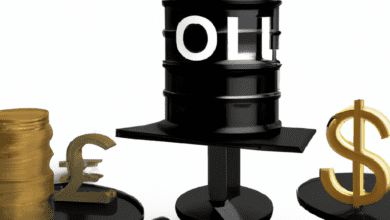Understanding Currency Depreciation and Appreciation: Causes, Effects, and Strategies in Global Markets

In today's interconnected global economy, understanding the dynamics of currency depreciation and appreciation is more crucial than ever. As the values of fiat currencies fluctuate, they significantly impact international trade, investment strategies, and the overall economic health of nations. Currency valuation affects everything from inflation rates to tourism, influencing how businesses and individuals approach currency conversion and cross-border payments. This article delves into the multifaceted world of currencies, exploring the key factors that drive currency movements and their broader economic effects. We will also examine the pivotal role of central bank policies in regulating currency stability, as well as strategies for navigating the forex market through currency trading and investment in emerging market currencies, stablecoins, and digital currencies. Whether you're an investor looking to hedge against currency risk or simply interested in understanding the forces behind currency trends, this comprehensive guide will equip you with the knowledge needed to navigate the complexities of global currency markets.
- 1. Understanding Currency Depreciation and Appreciation: Key Factors and Economic Impacts
- 2. The Role of Central Bank Policies in Currency Valuation and Market Stability
- 3. Currency Trading Strategies: Navigating Currency Pairs and Trends in the Forex Market
1. Understanding Currency Depreciation and Appreciation: Key Factors and Economic Impacts
Understanding currency depreciation and appreciation is crucial for grasping the dynamics of global economies. Currency valuation fluctuates due to various factors, impacting international trade, investments, and overall economic stability.
One primary driver of currency movements is economic indicators. For instance, inflation rates significantly affect currency values; higher inflation typically leads to currency depreciation as purchasing power diminishes. Conversely, low inflation can bolster a currency, resulting in appreciation. Central bank policies also play a pivotal role. When central banks adjust interest rates, they influence forex markets and can attract or repel foreign investment. For instance, higher interest rates tend to strengthen a currency by offering better returns on investments denominated in that currency.
Political stability and economic performance further affect currency valuation. Nations with stable governments and strong economic fundamentals are likely to experience appreciation of their fiat currencies. In contrast, emerging market currencies may face depreciation due to political turmoil or economic uncertainties. Currency wars, where countries intentionally devalue their currencies to boost exports, exemplify how competitive strategies in global currency markets can affect currency pairs and trading dynamics.
Additionally, technological advancements have introduced new forms of currencies, including cryptocurrencies and central bank digital currencies (CBDCs). These digital currencies create new opportunities and challenges in currency trading and investment strategies, such as currency hedging and currency arbitrage. The rise of stablecoins has also provided a more stable option for cross-border payments, appealing to businesses engaged in international trade.
Tourism is another sector that can be heavily influenced by currency trends. A strong currency can make a destination more expensive for foreign tourists, while a weaker currency can boost tourism by making travel more affordable. Currency conversion becomes vital for tourists, who must navigate these fluctuations to maximize their experiences.
In summary, currency depreciation and appreciation are influenced by a myriad of factors, including inflation, central bank policies, political stability, and emerging digital currencies. Understanding these dynamics is essential for anyone involved in global currency markets, whether they're currency traders, investors in currency ETFs, or businesses engaging in international trade. By staying informed about currency trends and employing effective currency strategies, stakeholders can better navigate the complexities of the global economy.
2. The Role of Central Bank Policies in Currency Valuation and Market Stability
Central banks play a pivotal role in the valuation of currencies and the stability of financial markets. Their policies directly influence forex dynamics, impacting everything from currency pairs to international trade. By adjusting interest rates, conducting open market operations, and managing currency reserves, central banks can mitigate currency depreciation or appreciation, thereby shaping currency trends.
One of the primary functions of central bank policies is to ensure price stability, which is crucial for maintaining the value of fiat currencies. For instance, when inflation rates rise excessively, central banks may increase interest rates to curb spending and stabilize the currency. This action can lead to appreciation of the currency, making it more attractive for investors and traders in the global currency markets. Conversely, during economic downturns, central banks might lower interest rates, potentially leading to currency depreciation as investors seek higher returns elsewhere.
Moreover, central banks often intervene in currency trading to prevent excessive volatility. This intervention can involve direct buying or selling of currencies to stabilize exchange rates, a practice known as currency pegs. In some cases, central banks may adopt fixed exchange rates to provide a more predictable environment for businesses engaged in international trade. This approach helps mitigate risks associated with currency conversion and supports emerging market currencies that may be more susceptible to rapid fluctuations.
In addition to traditional fiat currencies, the rise of digital currencies and stablecoins has introduced new dimensions to currency valuation. Central banks are increasingly exploring Central Bank Digital Currencies (CBDCs) as a means to improve cross-border payments and enhance monetary policy effectiveness. By integrating digital currencies into their frameworks, central banks can better respond to market dynamics and improve currency hedging strategies.
In the context of currency wars, central banks must navigate the delicate balance of maintaining competitiveness in global markets while avoiding aggressive devaluation tactics that can lead to economic tensions. Currency arbitrage opportunities arise when discrepancies in currency valuation exist, often influenced by central bank policies. Traders utilize these opportunities to profit from fluctuations in currency values, making an understanding of central bank actions crucial for effective currency strategies.
As tourism and international trade continue to rebound, central bank policies will remain a key factor influencing currency valuation. The interplay between currency futures, currency ETFs, and central bank actions will shape the landscape for both investors and consumers. Ultimately, the role of central banks in managing currency valuation and ensuring market stability cannot be overstated, as their decisions reverberate throughout the global economy.
3. Currency Trading Strategies: Navigating Currency Pairs and Trends in the Forex Market
In the dynamic world of global currency markets, understanding effective currency trading strategies is crucial for investors and traders looking to navigate the complexities of currency pairs and market trends. The forex market, known for its high liquidity and 24-hour trading, presents numerous opportunities for those keen on currency valuation and hedging against potential risks.
One fundamental aspect of currency trading involves analyzing currency pairs. Traders often look at major pairs, which involve fiat currencies like the USD, EUR, and JPY, as these are the most traded and offer substantial liquidity. However, emerging market currencies can also present unique opportunities, albeit with higher volatility. By keeping an eye on currency trends influenced by central bank policies, inflation rates, and geopolitical events, traders can make informed decisions that capitalize on currency appreciation or depreciation.
Another strategy widely employed in forex is currency arbitrage. This involves taking advantage of price discrepancies across different markets or exchanges. For instance, if the same currency pair is valued differently on two platforms, a trader can buy low on one and sell high on another, securing a profit with minimal risk. This strategy requires a keen eye and quick execution, as the forex market can move rapidly.
Currency futures and currency ETFs (exchange-traded funds) are also effective instruments for traders. These financial products allow investors to speculate on future currency movements or gain exposure to a basket of currencies without having to deal directly with currency conversion. For those looking to hedge against adverse currency fluctuations, especially in international trade or tourism, these instruments offer a protective layer.
Additionally, the rise of digital currencies and stablecoins has introduced new dynamics into currency trading strategies. Cryptocurrencies and CBDCs (central bank digital currencies) are becoming increasingly relevant as they challenge traditional fiat currencies. Traders must stay abreast of the evolving landscape of digital currencies, including their impact on cross-border payments and global currency markets.
Finally, understanding currency pegs and fixed exchange rates is essential for navigating currency wars and the effects they have on international trade. Countries may manipulate their currencies to gain a competitive advantage, leading to potential repercussions on currency reserves and global economic stability. By developing a nuanced understanding of these various strategies, traders can position themselves to navigate the ever-changing realm of currency trading effectively.
In conclusion, understanding the dynamics of currency depreciation and appreciation is essential for navigating the complexities of global currency markets. As we have explored, various factors influence currency valuation, including central bank policies, inflation rates, and international trade dynamics. The role of central banks is paramount in maintaining market stability through effective currency strategies, whether utilizing currency pegs or engaging in currency hedging.
As traders and investors delve into the world of forex, being aware of currency pairs and the implications of currency trading strategies such as currency arbitrage and futures can provide significant advantages. Furthermore, the rise of digital currencies, including stablecoins and CBDCs, is shaping the landscape of cross-border payments and international trade, presenting new opportunities and challenges for emerging market currencies.
Ultimately, staying informed about currency trends and leveraging the right tools—such as currency ETFs—can aid in making better investment decisions while mitigating risks associated with currency fluctuations. As the global economy continues to evolve, understanding the interplay between fiat currencies, cryptocurrencies, and their impact on tourism and international relations will be crucial for anyone involved in the realm of currency trading. By grasping these concepts, individuals and businesses can better position themselves within the ever-changing landscape of the forex market.
References:
– (Include relevant sources here)





